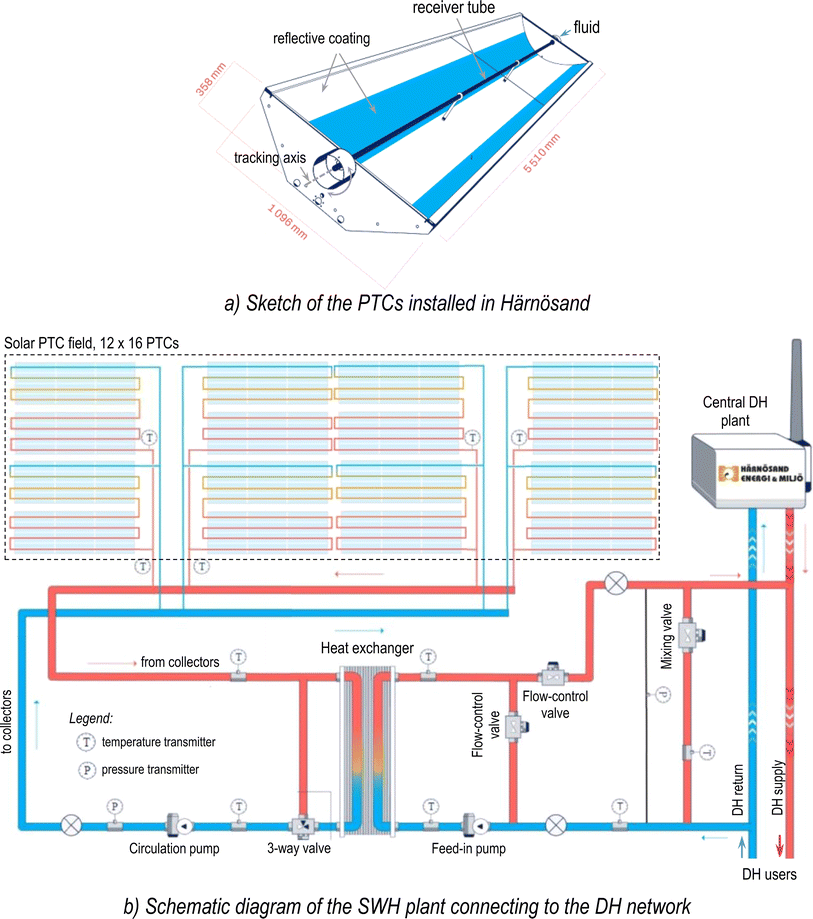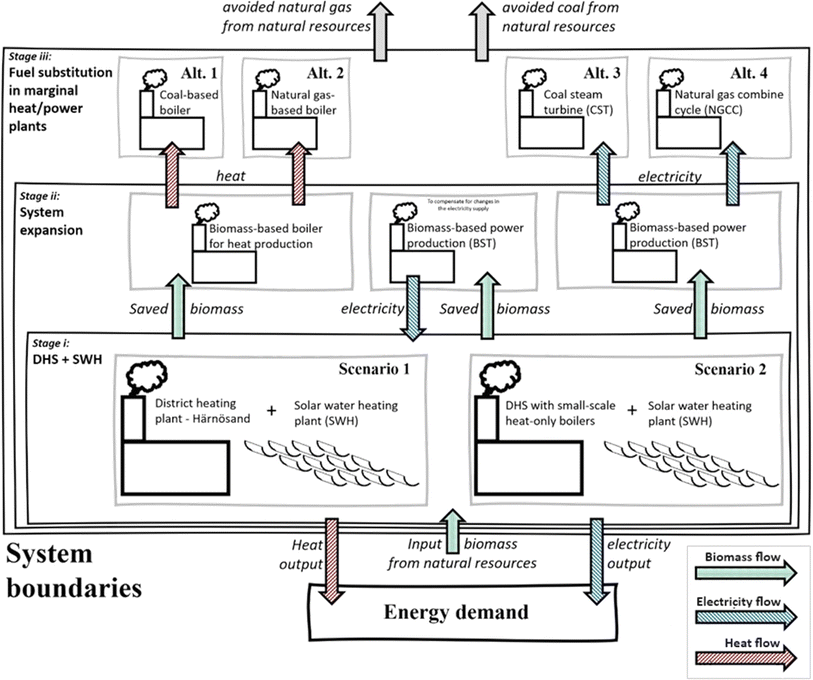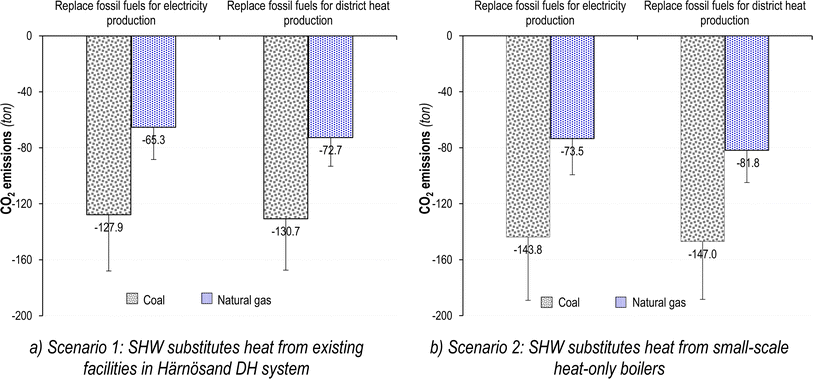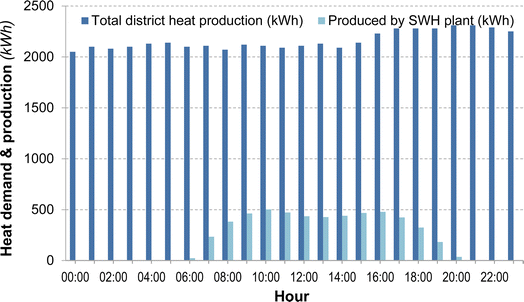 Open Access Article
Open Access ArticleCreative Commons Attribution 3.0 Unported Licence
Effects of solar thermal energy on district heating systems: the case of parabolic trough collectors in a high-latitude region
Truong
Nguyen
 *a,
Itai
Danielski
a,
Benjamin
Ahlgren
*a,
Itai
Danielski
a,
Benjamin
Ahlgren
 ab and
Gireesh
Nair
ab and
Gireesh
Nair
 a
a
aDepartment of Applied Physics and Electronics, Umeå University, Sweden. E-mail: truong.nguyen@umu.se
bWSP Sverige AB, Sweden
First published on 16th July 2024
Abstract
This study investigates primary energy use and CO2 emission reduction potential resulting from the integration of solar thermal heating in biomass-based district heating systems in high-latitude regions. A newly commissioned solar thermal system based on parabolic trough collectors for an existing district heating network in Härnösand, Sweden, is used as a case study, and its hourly one-year measured data are used as inputs for the analysis. The changes in operation and fuel use for local district heat production are extended to a regional context, considering the short- and long-term perspectives of the energy system. The results show that during the studied period, the solar water heating system provided 335 MWh of heat to the existing district heating system with a supply/return temperature of approximately 80/45 °C. Consequently, 339–382 MWh of biomass fuel consumption could be reduced annually with such an installation, depending on the district heat production technologies being substituted. An annual CO2 reduction of 65.3–189 tons can be achieved in an overall energy system perspective when the saved biomass substitutes fossil fuels. The reduction of CO2 emission depends on the fuels being substituted and energy conversion technology.
1. Introduction
The global energy system is currently based heavily on fossil fuels, and different renewable energy resources are mobilized to reduce this dependence and mitigate climate change. In the European Union (EU), the call for a climate-neutral Europe with the target of net-zero greenhouse gas (GHG) emissions by 2050![[thin space (1/6-em)]](https://www.rsc.org/images/entities/char_2009.gif) 1 has brought to the forefront the need to be self-sufficient in meeting its final energy demand using locally available energy resources. The current fuel mix of up to 77% from fossil fuels of coal, oil and natural gas in 2021
1 has brought to the forefront the need to be self-sufficient in meeting its final energy demand using locally available energy resources. The current fuel mix of up to 77% from fossil fuels of coal, oil and natural gas in 2021![[thin space (1/6-em)]](https://www.rsc.org/images/entities/char_2009.gif) 2 shows the importance of fast-tracking the mobilization of all locally available resources to achieve the climate target.
2 shows the importance of fast-tracking the mobilization of all locally available resources to achieve the climate target.
Heating accounts for almost half of the global final energy consumption in 2021. Approximately 46% of heat is used in buildings for space and water heating.3 Despite the significant decline in CO2 intensity per unit area of heated residential buildings, in total values, CO2 emissions reached a new record of 2500 Mt CO2 in 2020.3
Solar thermal energy, which is an abundant renewable resource, is deployed as supplementary for conventional fuel-based heat supply for buildings. By the end of 2022, 325 large-scale solar water heating (SWH) plants with a total installed capacity and aperture area of 1795 MWth and 2.56 million m2, respectively, were used for heat production globally.4 However, this option contributes to only 14% of the global heating demand in buildings.5 A disadvantage of solar thermal energy is the mismatch between its production potential and the heat demand. This mismatch becomes even more significant in higher-latitude regions, and therefore, solar thermal heating in buildings is less common in colder climates.
In cold weather climates, such as that in the Nordic countries, district heating (DH) is commonly used to provide heat to buildings. The widely available DH network offers the flexibility to integrate various energy conversion technologies,6 including fuel switching.7 According to Paardekooper et al.,8 future production and storage units for DH systems should be more versatile to integrate low-carbon technologies and enable flexibility in using different energy sources. Szarka et al.9 further showed that the role of bio-based energy use in a low-emission energy sector would shift from being an efficient source for base-load generation towards being an effective “stabilizer” for weather-dependent renewable energy such as direct heating from surplus wind and solar photovoltaic power, as well as solar-thermal and heat pumps in DH systems. Moreover, the incorporation of solar energy into DH has been identified as a measure for decarbonizing the heating sector by 2050, and for enabling the exploitation of variable renewable energy sources.10 An analysis considering different configurations of DH systems by Buoro et al.11 showed that an integrated solution of cogeneration, solar thermal and heat storage supply system turns out to be the best from both the economic and environmental points of view.
In Sweden, DH plays a crucial role in meeting the heat demands for both space and hot water in buildings, accounting for nearly 60% of the total heat demand in 2021.12 The DH production primarily relies on biomass, constituting approximately 66% of its energy resources in 2022.12 The use of solar thermal for DH production could contribute to the energy policy goals on security of heat supply. It can reduce the quantity of fuels being used for district heat production and contribute to the optimal use of biomass globally when the demand for biomass in other sectors increases. Solar thermal can also increase the diversification of the base-load heat production technologies, in the form of solar heat and in combination with energy storage, making the DH sector more resilient to increased fuel prices and energy security concerns.
The solar thermal potential in Sweden could exceed 6 TWh, with favourable conditions such as higher biofuel price and reduction of investment cost for solar thermal plants.13 This suggests a significant potential of solar thermal in the Swedish energy mix from the currently installed large-scale collector area of approximately 26![[thin space (1/6-em)]](https://www.rsc.org/images/entities/char_2009.gif) 000 m2, equivalent to approximately 18 MW.14 According to IEA SHC,15 25 systems above 500 m2 were in operation in 2020. On the other hand, in Denmark, the total solar thermal energy in DH systems was reported to be above 1 GW or approximately 1.9 million m2 aperture area,4 and the deployment over the last decade suggests potential for solar thermal, given the right conditions.
000 m2, equivalent to approximately 18 MW.14 According to IEA SHC,15 25 systems above 500 m2 were in operation in 2020. On the other hand, in Denmark, the total solar thermal energy in DH systems was reported to be above 1 GW or approximately 1.9 million m2 aperture area,4 and the deployment over the last decade suggests potential for solar thermal, given the right conditions.
Various types of solar thermal collectors are used for heat production, of which evacuated tube collectors are dominant globally.4 However, in Europe, flat plate collectors (FPC) are commonly used for large-scale solar thermal plants.4 An analysis by Noussan et al.16 for eight locations having latitudes between 54.4°–57.3° N suggests that heat yields from plants based on FTC can be higher than 400 kWh m−2. A simulation study in Alberta, Canada (55° N latitude) suggests that rooftop FPC of approximately 2300 m2, in combination with seasonal storage in a DH network, could meet 90% of the space heating demand of a small neighborhood of 52 detached houses.17 Studies that investigate the integration of solar thermal into DH systems, along with seasonal storage, suggest that solar energy can cover 50% to 80% of the total heat demand.18–20 However, these studies are based on simulations. As per the authors' knowledge, there is no published work based on measured data on solar heat integration with full-scale biomass-based DH networks at high latitudes. Further, the studies on the integration of solar thermal to DH systems are mostly based on FPC collectors. In addition, there is a lack of studies on SWH in DH systems that focus on the energy system perspective to reflect the overall impacts of primary energy use and CO2 emissions.
Among the different collector types, parabolic trough collectors (PTC) can provide heat directly for applications demanding high temperatures.21 This collector type is considered to be more effective than FPC once the mean collector temperatures need to be above 60–75 °C.22 An application of state-of-the-art PTCs together with FPCs for district heat production has been demonstrated in Taars, Denmark,23 showing the possibility of using such collectors to provide heat directly to the DH systems.24 For the Swedish context, when DH networks have medium- to high-temperature levels with an annual average supply temperature of 86 °C,25 using PTCs to provide heat directly to their supply line could be an option to reduce fuel use.
The replacement of heat from biomass-based boilers with solar thermal could also help reduce CO2 emissions. The use of solar energy as an external heat source has been recognized as a highly attractive method for increasing the share of renewable energy. Nevertheless, biomass, which has also been classified as a sustainable resource,26 can be used as a direct substitute for fossil fuels.27 Therefore, the biomass conserved through the use of solar thermal energy can be used to substitute fossil fuels in various applications, thereby decreasing the overall consumption and emissions of fossil fuels. However, current research predominantly focus on the direct impacts of solar heat and biomass for the decarbonization of district heating systems, such as Yuan et al.28 and Gobio-Thomas et al.,29 or effects of solar thermal installations as compared to biomass- and fossil-based systems, such as Mäki et al.18 The broader system perspective, particularly the substitution effects of saved biomass, has not been the primary focus of such studies.
In this study, the effects of integrating solar thermal heating with medium-temperature district heat production in high-latitude regions are investigated. The study is based on a SWH demonstration plant using PTCs, commissioned in autumn 2021, located in the city of Härnösand, Sweden (62.6° N, 17.94° E). Measured hourly data for one year of solar thermal yield from the SWH plant and operation of the local DH system is used to analyze the effects of the SWH on the DH system. A system analysis that includes the overall perspective of the European energy system is used to calculate the impacts of primary energy use and CO2 emissions from the installation. The saved combustible fuels at the local DH system are accounted as a contribution to the European energy system. Here, both the short- and the medium-term perspectives of energy resource use are studied.
2. Study descriptions and methodology
This study evaluates changes in energy resource use and the CO2 emission reduction potentials due to the integration of solar thermal in DH systems using biomass-based state-of-the-art technologies for district heat and electricity production. The analysis is based on the lower heating value (LHV) of fuels. We include a full fuel life cycle of each specific fuel type from natural resource to final energy carrier for the Swedish energy market.30The analysis is based on hourly measured data of the operation of different heat production units in the DH system in Härnösand and hourly measured heat production data from the SWH plant during July 1st 2022–June 30th 2023. The location of the central DH plant and the SWH plants is illustrated in Fig. 1.
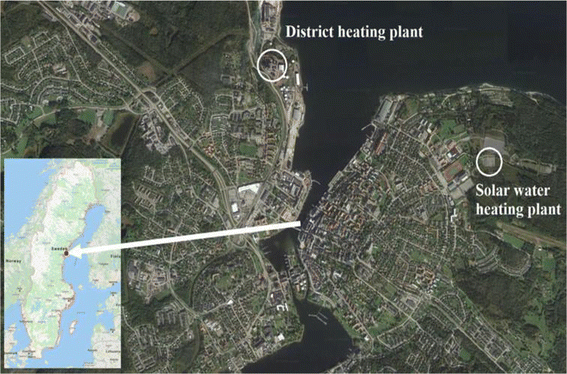 | ||
| Fig. 1 Location of Härnösand in Sweden and the sites of the DH and SWH plants in Härnösand. Aerial view from Google Maps.31 | ||
The SWH plant includes 192 PTCs with a total aperture area of 1056 m2 arranged in eight groups connected in parallel. Each group has 24 collectors connected in series, as illustrated in Fig. 2. Specific arrangements are, in general, a trade-off between the desired temperature rise from each parallel series, pressure drop and flow in the system. The solar collectors, aligned with the north-south tracking axis, use propylene glycol and water mixture as heat transfer fluid for the primary pressurized circulation loop. The control system monitors various parameters, including the fluid's temperature and the radiation intensity, to maintain a single-phase flow of the working fluid. By adjusting the circulation pump and valves, the system ensures optimal output temperature and maximizes the plant's efficiency. The plant has been in operation since autumn 2021, and there are plans to increase the aperture area to 2000 m2. Table 1 lists the major technical characteristics of the installed collectors. These parameters are based on the Solar Keymark Certificate of the collector model.32 The SHW plant connects to the return pipe of the existing DH network, and the temperature from the SWH plant is maintained at a minimum level of 73 °C and forwarded directly to DH users via the supply pipe of the existing DH system. The heat delivered to the DH network was measured and used for the analysis.
| Parameters | Value |
|---|---|
| Manufacturer | Absolicon, Sweden |
| Type | T160, glass-covered with one-axis tracking |
| Collector aperture area (Aap) | 5.51 m2 |
| Peak collector efficiency based on beam irradiance (η0,b) | 0.764 |
| Incidence angle modifier for diffuse solar radiation (Kd) | 0.120 |
| Heat loss coefficient (a1) | 0.80 W m−2 K−1 |
| Temperature dependence of the heat loss coefficient (a2) | 0.0000 W m−2 K−2 |
| Effective thermal capacity incl. fluid (C/AG) (a5) | 1626 W s m−2 K−1 |
2.1. District heat supply system
The DH system in Härnösand comprises a 257 km distribution network providing heating for 12![[thin space (1/6-em)]](https://www.rsc.org/images/entities/char_2009.gif) 000 people. The outdoor temperature varies from below −20 °C to over 30 °C (see Fig. 3a) in this location. The operation of the DH plant depends strongly on this outdoor temperature as it affects the demand for space heating. The DH system supplied 162 GWh of heat at a peak capacity of 63.9 MW during the study period.
000 people. The outdoor temperature varies from below −20 °C to over 30 °C (see Fig. 3a) in this location. The operation of the DH plant depends strongly on this outdoor temperature as it affects the demand for space heating. The DH system supplied 162 GWh of heat at a peak capacity of 63.9 MW during the study period.
 | ||
| Fig. 3 Data of the weather conditions in Härnösand and DH production profile during July 1st 2022–June 30th 2023.33,34 | ||
Two scenarios of solar thermal integration with the DH production system are included in this study. The first scenario is based on the configurations of the existing district heat production units in Härnösand. This system includes a 30 MWth CHP plant using wood chips, oil boilers, and industrial waste heat (Fig. 3b). The CHP plant, together with its associated flue gas condenser (FGC), produced approximately 75% of the total heat supply and 26.7 GWh of electricity during the studied period. During summers, when the heat production is the lowest, the CHP plant is usually not in operation. The heat production during this period is mainly from biomass boilers. This is also the period in which solar radiation is at its peak. In the second scenario, district heat production is based on heat-only boilers, which are the majority of the DH systems in Sweden.35 In this scenario, the SWH affects only the heat production from heat-only boilers and the electricity used to operate the boilers.
2.2. System integration and interaction
The marginal approach in a global market36 is used to calculate the changes in fuel consumption and CO2 emissions due to the integration of SWH to the district heat production in the city of Härnösand. Such an approach is considered to be suitable for new installations that contribute marginally to complex energy systems with different energy conversion technologies.37 In this approach, we assume that the heat produced in the SWH at any given hour during the measurement period replaces heat in the peak production technology in the DH plant at that specific hour (Fig. 3b). The changed energy resources are considered in the global context, in which energy systems still depend heavily on fossil fuels, and biomass is a limited resource with economic value that can be traded in the global energy market. Therefore, the saved biomass in the DH system, if any, could replace fossil fuels in other energy conversion facilities. Consequently, a change in biomass use in Sweden could influence the consumption of fossil fuels for energy purposes outside Sweden, at least in the short- and medium-term.The regional power grid is connected to the Nordic power system, which in turn, is connected to the EU power grid. Accordingly, any changes in the operation of the local SWH plant are assumed to have marginal effects on the EU's overall electricity production market. Here, we assume that production in marginal technologies will offset these marginal changes in the electricity production market. Currently, in the European energy market, coal- and natural gas-based power production are considered as the short- and long-term marginal technologies, respectively, due to their marginal costs,29i.e., these technologies are assumed to regulate their production according to marginal changes in the energy systems. The analysis in this study includes these marginal effects on a European energy system level. Thus, the system boundary in this analysis is expanded to include marginal production technologies of both heat and electricity. The analysis is carried out in three stages, as illustrated in Fig. 4, and the performance of the technologies for heat and electricity production is presented in Table 2.
| Technology | Conversion efficiency (%) | |
|---|---|---|
| Heat | Electricityj | |
| a Ref. 38 with similar electricity use as woodchip boilers. b Ref. 38 with an assumed electricity use of 1%. c Small-scale boilers.31 d Ref. 39, based on the lower range of 2020, i.e., without direct condensation and combustion air humidification and the auxiliary electricity consumption of 2.2% of the heat generated. e Ref. 39. f Ref. 32. g Pulverized coal.40 h Ref. 40. i Based on data for primary energy use and electricity production.41 j Negative value indicates that electricity is used for the operation of the boilers. | ||
| District heat production | ||
| Coal boilera | 89 | −2.0 |
| Fuel oil boilerb | 90.0 | −1.0 |
| Natural gas boilerc | 103 | −0.15 |
| Wood chips boiler – small-scaled | 89.0 | −2.0 |
| Wood chips boiler – with FGCe | 114.0 | −2.5 |
| CHP steam turbine, wood chipsd | 76.2 | 28.2 |
![[thin space (1/6-em)]](https://www.rsc.org/images/entities/char_2009.gif) |
||
| Standalone power production | ||
| Biomass steam turbinef | — | 45.0 |
| Coal-based steam turbineg | — | 46 |
| Natural gas combined cycleh | — | 56 |
| Coal-based power, EU-272018 averagei | — | 35.0 |
| Natural gas-based power, EU-272018 averagei | — | 42.9 |
Stage i: this stage evaluates the biomass saved in the local DH system due to the integration of the SWH plant. Two scenarios are considered in Stage i: (a) the SWH plant together with the existing DH system in Härnösand covering the heat demand. Since the DH system has a CHP plant, the integration of SWH influences the coproduction of electricity from the plant when the CHP plant is operated to cover the marginal changes of heat demand; (b) the SWH together with a small-scale DH system with heat-only boilers covering the heat demand.
Stage ii: the system is expanded to include two options to use the saved biomass from Stage i: (a) a standalone biomass-based heat production plant. A biomass-based boiler can have a higher conversion efficiency if it is equipped with an FGC to recover the low-temperature heat from the exhaust gas.42 However, this technology is not widely used in biomass-based boilers.43 Therefore, FGC is included only in the sensitivity analysis for the option using a standalone biomass-based heat production plant and (b) a standalone biomass-based power production plant.
In this analysis, changes in electricity supply to the grid are assumed to be generated by a biomass-based steam turbine (BST) power plant fueled by the saved biomass due to the integration of SWH in the DH plant. Three reasons contribute to the changes in electricity supply. Firstly, the SWH uses electricity for its own operation (as illustrated in Fig. 3), which is to be supplied by the power grid. Secondly, the reduction of heat production of the boilers in the DH plant reduces the electricity used for its own operation, thereby increasing the electricity availability to the grid. Thirdly, the reduction of heat production from the CHP unit in the DH plant will reduce its electricity coproduction and thus reduce the electricity supply to the grid. The reduction of cogenerated electricity is calculated based on the operated power-to-heat ratio of the CHP production unit (Table 2).
Stage iii: an additional expansion of the energy system boundary is made to include substitution effects of heat and electricity in marginal production technologies by the energy produced in Stage ii. The alternatives for marginal heat and electricity production are coal-based boilers and natural gas-based boilers for heat production (alternatives 1 and 2, respectively, in Fig. 4) and CST (coal-fired steam turbine) and NGCC (natural gas combined cycle) for electricity production (alternative 3 and 4, respectively in Fig. 4). In this stage, the change of fossil fuel use and corresponding CO2 emissions depend on the specific technologies. For electricity production, we consider marginal production technologies, which are power plants based on state-of-the-art technology. In addition, a sensitivity analysis was carried out to include power plants with EU-average conversion efficiency. This reflects the situation when the marginal change in electricity use influences the existing power plants in the EU. The conversion efficiencies of such technologies are shown in Table 2.
3. Results
Results are presented by first addressing the heat production from the SWH plant during the studied period and then looking at how that affected the DH system locally. The perspective is then widened to quantify the potential of the saved biomass to reduce fossil fuels in the energy system and the corresponding CO2 emission reduction.3.1. SWH demonstration plant within the DH system
Fig. 5 presents the monthly heat delivered by SWH to the DH system. Approximately 335 MWh of heat has been delivered to the DH network, and the SWH used approximately 10 MWh of electricity for its operation during the study period. The heat delivered by the SWH plant accounted for approximately 0.21% of the total annual heat production by the local DH network. However, during July 2022 and June 2023, the SWH accounted for 2.63% and 2.53% of the total monthly heat demand, respectively. Furthermore, during several days in these months, the contribution of SWH reached up to 12.1% of the daily heat production (see Appendix for such a day in July 2022).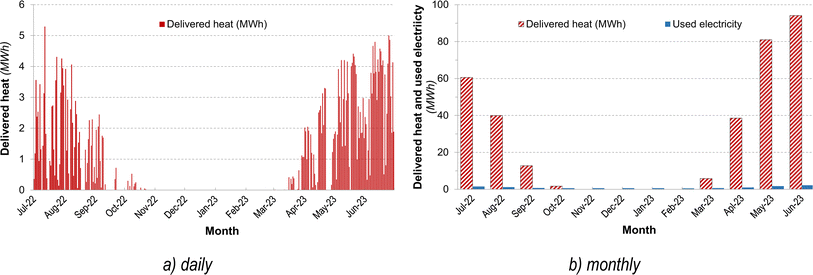 | ||
| Fig. 5 Measured daily and monthly average profile of the heat delivered to the DH system in Härnösand during July 1st, 2022–June 30th, 2023. | ||
3.2. Implications of the SWH demonstration plant for the studied DH system
The monthly changes in biomass supply to the DH system and the monthly change in electricity supply available to the grid due to the integration of the SWH plant are illustrated in Fig. 6a for DH system in Härnösand (Scenario 1) and Fig. 6b for a DH plant with with heat-only boilers (Scenario 2).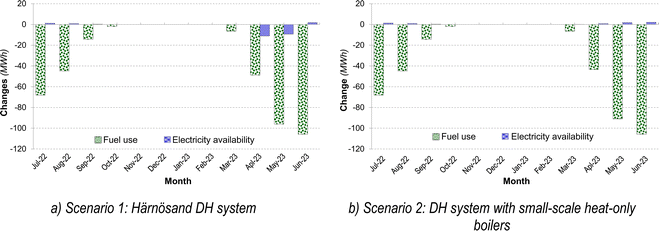 | ||
| Fig. 6 Change of fuel use and electricity availability at the district heat production facilities due to the integration of SWH. | ||
Negative values of fuels imply the reduction of fuel use in the DH plant due to the solar heat produced. Negative and positive values of electricity imply deficit and surplus of electricity in the electric grid, respectively.
In Scenario 1, the total fuel supply to the DH is reduced by 376 MWh, and the electricity supplied by the DH plant is reduced by 16.2 MWh over the study period. In Scenario 2, which has heat-only boilers, the equivalent values are 386 MWh reduction of fuel supply to the DH plant and a deficit of 7.5 MWh of electricity needs to be supplied to the grid by marginal power production.
3.3. System effects when avoided biomass usage replace marginal fuels
The change in electricity delivered to the grid, as discussed in Section 3.2 due to the integration of SWH, needs to be accounted for. It is assumed that this change in electricity production will affect the production in a standalone power plant with similar fuel, i.e., biomass-based steam turbine (BST) plant, as illustrated in Stage ii in Fig. 4, using system expansion.Fig. 7 illustrates the overall balance of the biomass fuel, including biomass avoided due to the integration of the SWH plant, the change in electricity production in standalone power plants, and the energy need for biomass production and transportation to the energy conversion facilities, i.e., a primary energy balance with a life cycle approach. The equivalent annual biomass savings for the DH system in Härnösand (Scenario 1) and for a DH plant with heat-only boilers (Scenario 2) are 339 MWh and 382 MWh, respectively. Also, Fig. 7a shows the increases in primary energy use for power production during the months of April–May 2023. During those periods, the CHP plant was operated to fulfill all the heat demand (Fig. 3b). Therefore, the heat production in SWH results in lower production of cogeneration of electricity in the CHP plant.
Fig. 8a and b illustrate the amount of primary energy that could be replaced depending on the considered final energy type (heat or electricity) and the substituted fossil fuel (coal or natural gas) for the two scenarios of DH production (Scenario 1 & 2), as discussed in Section 2.2. The error bars for electricity production represent the results of the sensitivity analysis using marginal power production based on EU-average conversion efficiency, whereas the error bars for heat production represent the results of the sensitivity analysis using a heat-only biomass boiler with an FGC. The results show that approximately 263–491 MWh of primary energy can be saved, depending on the scenarios of heat production and the types and technologies being used at the energy conversion facilities. The reduction in primary energy use was found to be higher for replacing coal in comparison to natural gas, varying from 13 to 26%. The primary energy reduction depends on the scenarios and the system expansion options (Stage ii, Fig. 4) and is higher with the integration of SWH in DH plants using heat-only boilers (Scenario 2) in comparison to DH plants with CHP as in Härnösand (Scenario 1).
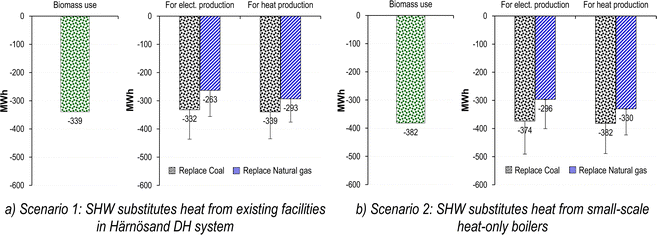 | ||
| Fig. 8 Change in biomass use and the consequent changes in fossil fuels when biomass replaces fossil fuels in marginal energy conversion facilities. | ||
Fig. 9 illustrates CO2 emission reduction by using the saved biomass to replace fossil fuels. The error bars for electricity production represent the results of the sensitivity analysis using marginal power production based on EU-average conversion efficiency, whereas the error bars for heat production represent the results of the sensitivity analysis using a heat-only biomass boiler with an FGC. The results show a value of 65.3–189 tons of CO2 emission reduction, depending on the scenarios of heat production and the considered final energy types. CO2 reduction is higher for replacing coal, up to 96%, in comparison to natural gas. Also, the use of the saved biomass for heat production is slightly higher than that for electricity generation. Further, CO2 emission reduction is higher by 13% with the integration of SWH in DH plants with a heat-only boiler (Scenario II) in comparison to DH plants with CHP as in Härnösand (Scenario I).
4. Discussion
The focus of this study is on the integration of solar thermal heating with medium-temperature district heat production in a high-latitude region. This study is based on real measurements in the first full 12-month period (during July 1st, 2022–June 30th, 2023) of heat production by a newly commissioned SWH plant after all the measuring equipment was put into operation. The heat produced by the SWH plant is directly used in the DH system in Härnösand, Sweden. The results of this study found that the SWH supplied 335 MWh of heat to the DH network. The supplied heat covered up to 2.63% and 12.1% of monthly and daily heat demand, respectively, so SWH production was significantly lower than the demand (see comparison in Appendix). However, for a larger SWH capacity, the mismatch between the heating demand and the availability of solar energy is to be accounted for. The heat produced in the SWH reduces 376 and 386 MWh of biomass in Scenario 1 and Scenario 2, respectively. This is equivalent to approximately 1400 tons of annual forest biomass reduction. The lower value in Scenario 1 is due to the reduction of cogenerated electricity that needs to be offset by external energy production utilities, thereby resulting in the use of additional energy resources. During summer months, the CHP plant is not in operation and heat demand is met by heat-only boilers (Fig. 3). Accordingly, the effect of reduced electricity availability for the grid is limited, which explains the small variation in biomass savings between the two scenarios.The saved biomass results in the reduction of fossil fuel use, and the corresponding primary energy savings are between 263 and 491 MWh. The highest value corresponds to the case when the saved biomass is used for heat production in a heat-only boiler (Stage ii in Fig. 4) with FGC with a coal-based boiler as the marginal heat production plant (Alt. 1 of Stage iii in Fig. 4). The lowest value corresponds to the case when the saved biomass is used in the BST power plant (Stage ii in Fig. 4) with NGCC as the marginal power plant (Alt. 4 of Stage iii in Fig. 4). The results are valid as long as the marginal energy conversion facilities are based on fossil fuels.
The results showed that an annual emission reduction potential of 65 to 189 tons of CO2 could be achieved depending on the configuration of the energy system, which corresponds to 194 to 564 kg of CO2 per MWh of heat produced by the SWH plant. The results also show that 11% higher CO2 emission reduction is achieved if the saved biomass in the DH plant is used in marginal heat production utilities in comparison to marginal power production utilities. The emission reduction potential is also found to be 80–96% higher if the saved biomass is used to replace coal for heat production in comparison to natural gas for electricity production. Currently, an emission factor of 58.3 g CO2 per kWh is used for heat delivered by DH in Härnösand,44 which is significantly lower than that found in this study using a system perspective of biomass in the European energy system. This may lower the incentive for DH companies to integrate SWH into their systems. Further, if the use of primary biomass is avoided and left in nature, i.e., as standing trees or logging residues, it may have an additional positive effect on emission reduction that is not reflected in the emission factor used by the DH companies. To calculate this reduction, there is a need to include the effects of land use, forestry management, and time dynamics of GHG emissions, which is beyond the scope of this article and requires further investigation.
This study reveals the impacts of a SWH plant using PTCs in a DH system, specifically in terms of primary energy use and CO2 emission reduction. However, the focus of this study is not to evaluate the performance of the collectors. Such assessment would require the use of standards such as ISO 24194:2022 and ISO 9806:2017, which is beyond the scope of this research. It is important to note that during the initial years of operation, a SWH plant may undergo a period of fine-tuning and operational adjustments. This optimization process could enhance the operational conditions and further improve the plant's solar energy output. Additionally, the heat production from the SWH plant may exhibit variability on an annual basis, largely influenced by changing weather conditions. The study used the first twelve months of the collected data for further analysis, and according to the Swedish Meteorological and Hydrological Institute,45 the global horizontal irradiance during the studied period was within 2% of the mean yearly value of the last decade. It is possible to reduce the internal shading loss in a solar thermal plant by changing the collector layout to a sparser configuration. A sparser configuration lead to an increase in collector output due to reduced shading loss. However, it reduce the number of collectors per unit of land area. Further, during the study period, the insulation on connections between collectors and feed piping was incomplete, which contributed to the energy loss. Besides, a full life cycle of the SWH plant, including its construction and end-of-life, together with its cost-benefits in comparison to other heat production technologies, will provide a comprehensive picture of GHG emissions. In addition, an increased share of solar heat in DH networks, together with the application of seasonal thermal storage, could significantly influence the operation of the DH plant, and these are areas for further investigation.
5. Conclusions
This study has analyzed the system effects of a SWH plant based on PTCs in an existing DH network situated in a high-latitude region (62.6° N). The SWH plant, with an area of 1056 m2, contributed approximately 335 MWh of heat annually to the DH network, leading to a biomass fuel reduction of 376–386 MWh each year. The heat supplied by the SWH accounted for up to 2.63% of the monthly and 12.1% of the daily heat demand.In this case study, by using the marginal approach with system expansion to include the EU energy system, the integration of SWH in the DH system resulted in a decrease in fossil fuel usage, ranging from 263 to 491 MWh. This corresponds to a reduction of 194 to 564 kg of CO2 per MWh of heat generated by the SWH plant. The emission factor currently used by the Swedish DH industry is lower than the findings of this study. The system approach adopted in this analysis offers a more accurate representation of the impacts of CO2 emission when integrating renewable energy into energy systems.
While the results are based on measured data from a specific location, the findings could be relevant for systems employing similar technology and operating under comparable conditions. Furthermore, the methodology applied in this study can serve as a valuable tool for analyzing the effect of integrating renewable energy resources into any DH system. This study, therefore, contributes to the understanding of renewable energy integration in energy systems.
Nomenclature
| CHP | Combined heat and power |
| CST | Coal-fired steam turbine |
| DH | District heating |
| EU | European Union |
| FGC | Flue gas condenser |
| FPC | Flat plate collectors |
| GHG | Greenhouse gas emissions |
| LHV | Lower heating value |
| NGCC | Natural gas combined cycle |
| PTC | Parabolic trough collector |
| SWH | Solar water heating |
Data availability
Data will be made available upon request.Conflicts of interest
One of the co-authors, Benjamin Ahlgren, has been employed by Absolicon Collector AB during the course of the study. The authors declare that they have no known competing financial interests or personal relationships that could have appeared to influence the work reported in this paper.Appendix
Hourly district heat production and contribution of the SWH plant on July 12th, 2022.Acknowledgements
The authors gratefully acknowledge the financial support from the Swedish Energy Agency for the projects “Soldriven fjärrvärme för hållbara städer”(project no. 50037-1) and “RESILIENTa Energisystem Kompetenscentrum” (project no. 52686-1). We are grateful to Härnösand Energi & Miljö AB for providing us with the relevant production data of the district heating plant. The authors are also grateful to Absolicon Solar Collector AB for providing access to relevant data from the studied solar thermal plant in Härnösand.References
- European Commission, The European Green Deal – Communication from the Commission to the European Parliament, the Council, the European Economic and Social Committee and the Committee of the Regions, 2019, web accessed at: https://eur-lex.europa.eu/legal-content/EN/TXT/PDF/?uri=CELEX:52019DC0640%26from=EN, on April 2021 Search PubMed.
- IEA, World Energy Outlook 2022, International Energy Agency, 2022, web-accessed at: https://iea.blob.core.windows.net/assets/830fe099-5530-48f2-a7c1-11f35d510983/WorldEnergyOutlook2022.pdf Search PubMed.
- IEA, Heating, International Energy Agency (IEA), Paris, 2022, p. , p. 224, web-accessed at: https://www.iea.org/fuels-and-technologies/heating Search PubMed.
- W. Weiss and M. Spörk-Dür, Solar heat world wide – Edition 2023, IEA Solar Heating & Cooling Programme, 2023, p. , p. 88, web accessed at: https://www.iea-shc.org/Data/Sites/1/publications/Solar-Heat-Worldwide-2023.pdf Search PubMed.
- IEA, Renewables 2021, International Energy Agency (IEA), Paris, 2021, p. , p. 224, https://www.iea.org/reports/renewables-2021, License: CC BY 4.0 Search PubMed.
- N. Fernqvist, S. Broberg, J. Torén and I.-L. Svensson, District heating as a flexibility service: Challenges in sector coupling for increased solar and wind power production in Sweden, Energy Policy, 2023, 172, 113332 CrossRef.
- C. Kjær, M. L. Vølstad, and A. Gogstad, Renewable Energy in the Nordics 2021, Nordic Energy Research, Stensberggata 27, NO-0170 Oslo, Norway, 2021, web-access at, p. 62, https://pub.norden.org/ Search PubMed.
- S. Paardekooper, R. Lund, B. Mathiesen, M. Chang, U. Petersen, L. Grundahl, et al., Heat Roadmap Europe 4: Quantifying the Impact of Low-Carbon Heating and Cooling Roadmaps, Aalborg Universitetsforlag, 2018, p. , p. 224, web-assecced at: https://vbn.aau.dk/ws/portalfiles/portal/288075507/Heat_Roadmap_Europe_4_Quantifying_the_Impact_of_Low_Carbon_Heating_and_Cooling_Roadmaps.pdf Search PubMed.
- N. Szarka, V. Lenz and D. Thrän, The crucial role of biomass-based heat in a climate-friendly Germany–A scenario analysis, Energy, 2019, 186, 115859 CrossRef.
- European Commission, Directorate-General for Research and Innovation, Final report of the High-Level Panel of the European Decarbonisation Pathways Initiative, Publications Office, 2018, DOI:10.2777/636.
- D. Buoro, P. Pinamonti and M. Reini, Optimization of a Distributed Cogeneration System with solar district heating, Appl. Energy, 2014, 124, 298–308 CrossRef.
- Swedish Energy Agency, Energy in Sweden – Facts and figures 2023, Energimyndigheten, Box 310, 631 04 Eskilstuna, Sweden, 2023, web-accessed at: http://www.energimyndigheten.se Search PubMed.
- Swedish Energy Agency, Solar heating in Sweden – A study with a focus on potential, economy and contribution to energy and climate goals (In Swedish: Solvärme i Sverige – En studie med fokus på potential, ekonomi och bidrag till energi- och klimatmål), Energimyndigheten, Box 310, 631 04 Eskilstuna, Sweden, 2019, web-accessed at: https://energimyndigheten.a-w2m.se/Home.mvc?ResourceId=203602 on 14/4/2023 Search PubMed.
- Solar District Heating, Plant database – Ranking List of European Large Scale Solar Heating Plants, Solar District Heating (SDH), 2023, web-assecced at: https://www.solar-district-heating.eu/en/plant-database/, on April 14th, 2023 Search PubMed.
- IEA SHC, Task 55 Towards the Integration of Large SHC Systems into DHC Networks. D-D4. Market development for large scale SDH/SDC systems in country reports, Solar Heating & Cooling Programme, International Energy Agency, 2020, p. , p. 88, web accessed at: http://task55.iea-shc.org/fact-sheets Search PubMed.
- M. Noussan, M. Jarre, L. Degiorgis and A. Poggio, Data Analysis of the Energy Performance of Large Scale Solar Collectors for District Heating, Energy Procedia, 2017, 134, 61–68 CrossRef.
- B. Sibbitt, D. McClenahan, R. Djebbar, J. Thornton, B. Wong and J. Carriere, et al., The Performance of a High Solar Fraction Seasonal Storage District Heating System – Five Years of Operation, Energy Procedia, 2012, 30, 856–865 CrossRef.
- E. Mäki, L. Kannari, I. Hannula and J. Shemeikka, Decarbonization of a district heating system with a combination of solar heat and bioenergy: a techno-economic case study in the Northern European context, Renewable Energy, 2021, 175, 1174–1199 CrossRef.
- C. Flynn and K. Sirén, Influence of location and design on the performance of a solar district heating system equipped with borehole seasonal storage, Renewable Energy, 2015, 81, 377–388 CrossRef.
- J. Hirvonen, H. ur Rehman and K. Sirén, Techno-economic optimization and analysis of a high latitude solar district heating system with seasonal storage, considering different community sizes, Sol. Energy, 2018, 162, 472–488 CrossRef.
- E. Bellos and C. Tzivanidis, Alternative designs of parabolic trough solar collectors, Prog. Energy Combust. Sci., 2019, 71, 81–117 CrossRef.
- D. Krüger, F. Heller, K. Hennecke and K. Duer, Parabolic Trough Collectors for District Heating Systems at High Latitudes? – A Case Study, 2000 Search PubMed.
- Swedish Energy Agency, Brønderslev Hybrid Solar Power Plant: Performance Analysis and Monitoring Report, Technical University of Denmark, Department of Civil Engineering, 2020, p. , p. 29, (BYG Report; No. R-449), web-accessed at: https://orbit.dtu.dk/en/publications/br%C3%B8nderslev-hybrid-solar-power-plant-performance-analysis-and-mon, on 14/4/2023 Search PubMed.
- Z. Tian, B. Perers, S. Furbo and J. Fan, Analysis and validation of a quasi-dynamic model for a solar collector field with flat plate collectors and parabolic trough collectors in series for district heating, Energy, 2018, 142, 130–138 CrossRef.
- S. Werner, District heating and cooling in Sweden, Energy, 2017, 126, 419–429 CrossRef.
- M. Kaltschmitt, Biomass as Renewable Source of Energy: Possible Conversion Routes, in Energy from Organic Materials (Biomass): A Volume in the Encyclopedia of Sustainability Science and Technology, ed. M. Kaltschmitt, Springer New York, New York, NY, 2nd edn, 2019, pp. 353–389 Search PubMed.
- M. Farghali, A. I. Osman, I. M. A. Mohamed, Z. Chen, L. Chen and I. Ihara, et al., Strategies to save energy in the context of the energy crisis: a review, Environ. Chem. Lett., 2023, 21(4), 2003–2039 CrossRef CAS PubMed.
- P. Yuan, L. Duanmu, Z. Wang, S. Gao and H. Zheng, Thermal performance of solar-biomass energy heating system coupled with thermal storage floor and radiators in northeast China, Appl. Therm. Eng., 2024, 236, 121458 CrossRef CAS.
- L. B. Gobio-Thomas, M. Darwish and V. Stojceska, Environmental impacts of solar thermal power plants used in industrial supply chains, Therm. Sci. Eng. Prog., 2023, 38, 101670 CrossRef.
- J. Gode, F. Martinsson, L. Hagberg, A. Öman, J. Höglund, and D. Palm, Estimated Emission Factors for Fuels, Electricity, Heat and Transport in Sweden – Miljöfaktaboken 2011, Värmeforsk, Stockholm, 2011, vol. 2011 Search PubMed.
- Google Maps, Map of Sweden and Härnösand Municipality, Google Maps, 2023, web accessed at: https://www.google.com/maps/place/H%C3%A4rn%C3%B6sand/@62.6312277,17.9304301,3163m/data=!3m1!1e3!4m6!3m5!1s0x4664834936ad79d3:0x145f5626d9ee49b3!8m2!3d62.6322698!4d17.9408714!16zL20vMDNfMTN5?entry=ttu Search PubMed.
- Solar Keymark, Solar Keymark Certificate – Model T160 Absolicon Solar Colelctor AB, Solar keymark – CEN Keymark scheme, 2019, web-accessed at: https://www.duurzaamloket.nl/DBF/PDF_Downloads/DS_2013.pdf Search PubMed.
- SMHI, Data of global irradiance – Extracting STRÅNG data, Swedish Meteorological and Hydrological Institute (SMHI), 2024, web-accessed at https://strang.smhi.se/extraction/index.php Search PubMed.
- A. Lundgren, Operation data of existing district heat production units in Härnörsand Municipality, Sweden. Personal Communications with Anders Lundgren from Härnösand Energi & Miljö AB, Sweden, 2023 Search PubMed.
- Energimarknadsinspektionen, Statistics of Technical data – district heating (in Swedish: Statistik – Produktion per prisområde), The Swedish Energy Markets Inspectorate (Ei), 2022, web-accessed at: https://ei.se/om-oss/statistik-och-oppna-data/tekniska-uppgifter---fjarrvarme Search PubMed.
- L. Gustavsson and Å. Karlsson, CO2 Mitigation: On Methods and Parameters for Comparison of Fossil-Fuel and Biofuel Systems, Mitigation and Adaptation Strategies for Global Change, 2006, 11(5), 935–959 CrossRef.
- V. Olkkonen and S. Syri, Spatial and temporal variations of marginal electricity generation: the case of the Finnish, Nordic, and European energy systems up to 2030, J. Cleaner Prod., 2016, 126, 515–525 CrossRef.
- E. Ahlgren, E. Andersson, E. Axelsson, M. Börjesson, E. Fahlén, S. Harvey, et al., Biokombi Rya – Final Report from Sub-projects (In Swedish: Biokombi Rya – Slutrapporter Från Ingående Delprojekt), in CEC report 2007:3, Centre for Coordinated Energy Research (Chalmers EnergiCentrum-CEC), Chalmers University of Technology, Göteborg, Sweden, 2007, web-accessed at http://publications.lib.chalmers.se/records/fulltext/65604.pdf, on 1/4/2017 Search PubMed.
- Danish Energy Agency, Technology Data for Energy Plants for Electricity and District Heat Generation, Updated June 2022, Danish Energy Agency, 2022, web-accessed at: https://ens.dk/en/our-services/projections-and-models/technology-data/technology-data-generation-electricity-and, on 15/12/2022 Search PubMed.
- Danish Energy Agency, Technology Data for Energy Plants – Generation of Electricity and District Heating, Energy Storage and Energy Carrier Generation and Conversion, Danish Energy Agency, 2012, p. , p. 211, web-accessed at http://www.energinet.dk/SiteCollectionDocuments/Danskedokumenter/Forskning/Technology_data_for_energy_plants.pdf Search PubMed.
- IEA, World Energy Outlook 2019, International Energy Agency, 2019, web-accessed at: https://iea.blob.core.windows.net/assets/98909c1b-aabc-4797-9926-35307b418cdb/WEO2019-free.pdf Search PubMed.
- J. F. P. Cornette, T. Coppieters, H. Lepaumier, J. Blondeau and S. Bram, Particulate matter emission reduction in small- and medium-scale biomass boilers equipped with flue gas condensers: Field measurements, Biomass Bioenergy, 2021, 148, 106056 CrossRef CAS.
- T. Coppieters, J. Fricker and J. Blondeau, Techno-economic performances of active condensation in a medium-scale biomass-fired district heating unit, Case Stud. Therm. Eng., 2022, 33, 101914 CrossRef.
- Energiföretagen, Environmental assessment of district heating (in Swedish: Miljövärdering av fjärrvärme), 2023, web accessed at: https://www.energiforetagen.se/statistik/fjarrvarmestatistik/miljovardering-av-fjarrvarme/, on Febuary, 2024 Search PubMed.
- SMHI, Climate Indicator – Global Radiation, Swedish Meteorological and Hydrological Institute, 2024, web-accessed at https://www.smhi.se/en/climate/climate-indicators/climate-indicators-global-radiation-1.91484, on 27/2/2024 Search PubMed.
| This journal is © The Royal Society of Chemistry 2024 |

